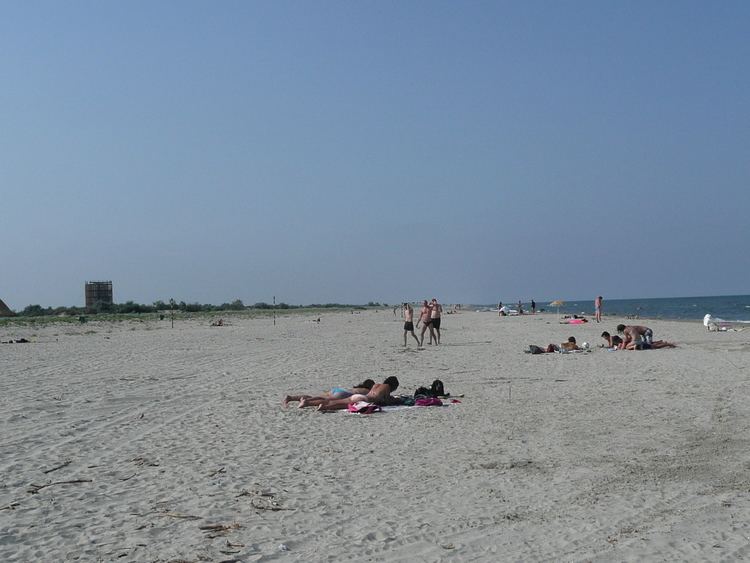Status County capital Climate Dfb Local time Friday 2:23 AM | Time zone EET (UTC+2) Population 54,312 (2011) | |
 | ||
Weather 7°C, Wind NE at 8 km/h, 79% Humidity | ||
Sfântu Gheorghe ([ˈsfɨntu ˈɡe̯orɡe]; Hungarian: Sepsiszentgyörgy or Szentgyörgy, [ˈʃɛpʃisɛnɟørɟ]; Yiddish: סנט דשזארדזש) is the capital city of Covasna County, Romania. Located in the central part of the country and in the historical region of Transylvania, it lies on the Olt River in a valley between the Baraolt Mountains and Bodoc Mountains. The city administers two villages, Chilieni (Kilyén) and Coșeni (Szotyor).
Contents
Map of Sf%C3%A2ntu Gheorghe, Romania
Demographics
The majority of the city's inhabitants are Hungarians. In the census of 2011, 41,770 (77%) of the city's 54,312 inhabitants classed themselves as ethnic Hungarians, 11,921 (22%) as Romanians, 420 (0.8%) as Roma, and 201 as "others."
History
Sfântu Gheorghe is one of the oldest cities in Transylvania, the settlement first having been documented in 1332. The city takes it name from Saint George, the patron of the local church. Historically it was also known in German as Sankt Georgen. The "sepsi" prefix (sebesi → sepsi, meaning "of Sebes") refers to the area which the ancestors of the local Székely population had inhabited before settling to the area of the town. The previous area of their settlement was around the town of "Sebes" (now: Sebeș) which later became populated mainly by Transylvanian Saxons.
While part of the Kingdom of Hungary, the city was the economic and administrative center of the Hungarian county of Háromszék, which spanned the present-day Covasna County and parts of Brașov County. In the second half of the 19th century, Sepsiszentgyörgy witnessed the development of light industry, namely a textile and a cigarette factory was built. It became part of the Kingdom of Romania following the Treaty of Trianon in 1920, after the end of World War I. After the Second Vienna Award in 1940 the city came under Hungarian control for four years. Near the end of that period, the Sfântu Gheorghe ghetto briefly existed in the city. At the end of the Second World War the Paris Peace Treaties reaffirmed the city and the entirety of Transylvania as a Romanian territory. Between 1952-1960 it was the southernmost town of the Magyar Autonomous Region, and between 1960-1968 was part of the Brașov Region, abolished in 1968 when Romania was reorganised based on counties rather than regions.
Sfântu Gheorghe is one of the centres for the Székely people in the region known to them as Székelyföld in Hungarian - which means "Székely Land", and is home to the Székely National Museum. The city hosts two market fairs each year.
Sights
Economy
The predominant industry in the city is the textile industry. The city holds underutilized production capabilities such as a downsized automobile transmission parts and gearboxes factory (IMASA SA) and a tobacco factory (TIGARETE SA). At the time of its closing SA was the last place where they produced iconic Romanian cigarette brands such as "Carpați", "Snagov" or "Mărășești".
Services sector contains growing areas such as IT services with ROMARG SRL the leading domain registrar and web hosting provider in Romania having its headquarters here.
Sports
The main sport in the city is football. The city has a men football team called ACS Sepsi OSK Sfântu Gheorghe (Sepsiszentgyörgyi OSK). In the 2015-2016 season the team promoted from the 3rd Division and currently play in the 2nd Division.
The city has also women basketball team called ACS Sepsi SIC
In the 2015-2016 season the club wins the Romanian Cup and for the first time was the Romanian Championship beating in the Final CSU Alba Iulia (3-0).
The city also has a futsal team which plays in the Romanian First Division. The name of the team is Futsal Club Sfântu Gheorghe (Sepsiszentgyörgyi Futsal Club).
Culture
The Hungarian artist Jenő Gyárfás was born there and was a lifelong resident. His former studio is now an art gallery and exhibition hall.
